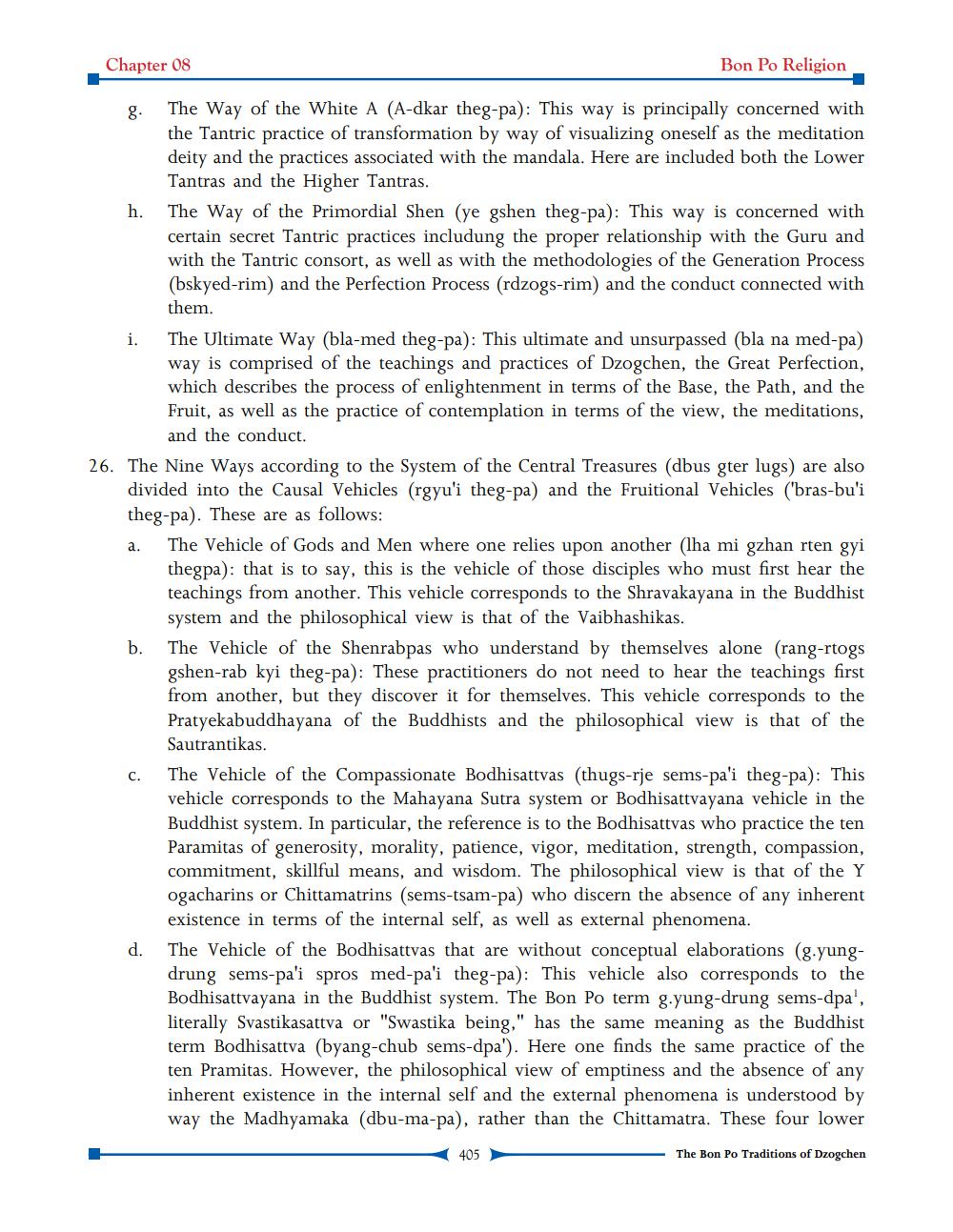________________
Chapter 08
Bon Po Religion
The Way of the White A (A-dkar theg-pa): This way is principally concerned with the Tantric practice of transformation by way of visualizing oneself as the meditation deity and the practices associated with the mandala. Here are included both the Lower Tantras and the Higher Tantras.
g.
h. The Way of the Primordial Shen (ye gshen theg-pa): This way is concerned with certain secret Tantric practices includung the proper relationship with the Guru and with the Tantric consort, as well as with the methodologies of the Generation Process (bskyed-rim) and the Perfection Process (rdzogs-rim) and the conduct connected with them.
i.
26. The Nine Ways according to the System of the Central Treasures (dbus gter lugs) are also divided into the Causal Vehicles (rgyu'i theg-pa) and the Fruitional Vehicles ('bras-bu'i theg-pa). These are as follows:
The Ultimate Way (bla-med theg-pa): This ultimate and unsurpassed (bla na med-pa) way is comprised of the teachings and practices of Dzogchen, the Great Perfection, which describes the process of enlightenment in terms of the Base, the Path, and the Fruit, as well as the practice of contemplation in terms of the view, the meditations, and the conduct.
a. The Vehicle of Gods and Men where one relies upon another (lha mi gzhan rten gyi thegpa): that is to say, this is the vehicle of those disciples who must first hear the teachings from another. This vehicle corresponds to the Shravakayana in the Buddhist system and the philosophical view is that of the Vaibhashikas.
C.
d.
The Vehicle of the Shenrabpas who understand by themselves alone (rang-rtogs gshen-rab kyi theg-pa): These practitioners do not need to hear the teachings first from another, but they discover it for themselves. This vehicle corresponds to the Pratyekabuddhayana of the Buddhists and the philosophical view is that of the Sautrantikas.
The Vehicle of the Compassionate Bodhisattvas (thugs-rje sems-pa'i theg-pa): This vehicle corresponds to the Mahayana Sutra system or Bodhisattvayana vehicle in the Buddhist system. In particular, the reference is to the Bodhisattvas who practice the ten Paramitas of generosity, morality, patience, vigor, meditation, strength, compassion, commitment, skillful means, and wisdom. The philosophical view is that of the Y ogacharins or Chittamatrins (sems-tsam-pa) who discern the absence of any inherent existence in terms of the internal self, as well as external phenomena.
The Vehicle of the Bodhisattvas that are without conceptual elaborations (g.yungdrung sems-pa'i spros med-pa'i theg-pa): This vehicle also corresponds to the Bodhisattvayana in the Buddhist system. The Bon Po term g.yung-drung sems-dpa". literally Svastikasattva or "Swastika being," has the same meaning as the Buddhist term Bodhisattva (byang-chub sems-dpa'). Here one finds the same practice of the ten Pramitas. However, the philosophical view of emptiness and the absence of any inherent existence in the internal self and the external phenomena is understood by way the Madhyamaka (dbu-ma-pa), rather than the Chittamatra. These four lower
The Bon po Traditions of Dzogchen
405




